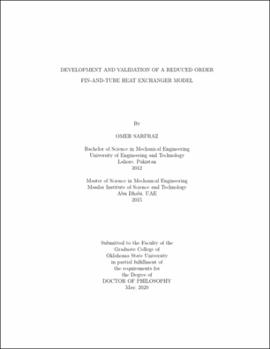| dc.contributor.advisor | Bach, Christian K. | |
| dc.contributor.author | Sarfraz, Omer | |
| dc.date.accessioned | 2020-08-24T16:39:32Z | |
| dc.date.available | 2020-08-24T16:39:32Z | |
| dc.date.issued | 2020-05 | |
| dc.identifier.uri | https://hdl.handle.net/11244/325403 | |
| dc.description.abstract | Vapor compression systems are the most widely used cooling system type in heating, ventilation, and air-conditioning (HVAC) applications. Two of the four basic components of a vapor compression system are heat exchangers, one of which acts as an evaporator while the other acts as a condenser. Air-to-refrigerant fin-and-tube heat exchangers are used extensively in both residential and commercial vapor compression systems. Designers and manufacturers use simulation models to predict heat exchanger performance during the design phase. These models reduce the cost associated with the experimental iterations needed during new product development. | |
| dc.description.abstract | There are numerous simulation models developed to design fin-and-tube heat exchangers since 1980s. These models have been continuously updated, adding more complexity to the calculation procedures to address various geometric refinements of tubes and fins and an increased range of refrigerants. Cross-fin conduction is an important phenomenon that is ignored by many state-of-the-art heat exchanger models due to increased complexity and simulation time. Cross-fin conduction is the heat transfer between adjacent heat exchanger tubes via fins. It can significantly affect the heat exchanger performance if there is significant temperature difference between the adjacent heat exchanger tubes e.g. in gas coolers and in commercial multi-system coils. Unaccounted for cross-fin conduction can lead to an inaccurate prediction of heat exchanger performance. | |
| dc.description.abstract | In this thesis, a detailed segment-by-segment model, Xfin model is developed that has the ability to calculate the cross-fin conduction. This model is validated against the single-phase and two-phase experimental data. | |
| dc.description.abstract | The calculation of wall temperature of all tube segments in heat exchanger is required in Xfin model for cross-fin conduction calculation that increases the simulation time by 20-25 times when the cross-fin conduction is ignored. To address this issue, a fin discretized model (FD model) is developed that discretizes fin surface area to associate the fin area of inactive tubes with the neighboring active tubes to include conduction path, thereby eliminating the need to calculate tube segments' wall temperatures. | |
| dc.description.abstract | Finally, to reduce simulation time of both Xfin and FD models, a reduced order modeling technique is established that reduces simulation time by simulating reduced number of identical circuits in a multi-circuit heat exchanger with multiple identical circuits. | |
| dc.format | application/pdf | |
| dc.language | en_US | |
| dc.rights | Copyright is held by the author who has granted the Oklahoma State University Library the non-exclusive right to share this material in its institutional repository. Contact Digital Library Services at lib-dls@okstate.edu or 405-744-9161 for the permission policy on the use, reproduction or distribution of this material. | |
| dc.title | Development and validation of a reduced order fin-and-tube heat exchanger model | |
| dc.contributor.committeeMember | Bradshaw, Craig R. | |
| dc.contributor.committeeMember | Fisher, Daniel E. | |
| dc.contributor.committeeMember | Park, Ilchung | |
| osu.filename | Sarfraz_okstate_0664D_16624.pdf | |
| osu.accesstype | Open Access | |
| dc.type.genre | Dissertation | |
| dc.type.material | Text | |
| dc.subject.keywords | cross-fin conduction | |
| dc.subject.keywords | fin discretized model | |
| dc.subject.keywords | fin-and-tube heat exchanger | |
| dc.subject.keywords | modeling | |
| dc.subject.keywords | segment-by-segment model | |
| dc.subject.keywords | tube-to-tube conduction | |
| thesis.degree.discipline | Mechanical and Aerospace Engineering | |
| thesis.degree.grantor | Oklahoma State University | |
